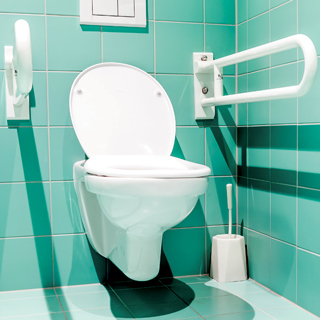
Scientists, medical research and lots of equity, both sweat and money, have led to remarkable advances toward cures for things such as cancer and Alzheimer’s disease. This leaves many wondering why a seemingly benign issue such as incontinence — which affects far more seniors than any single deadly disease — hasn’t been “cured” yet.
“Nobody dies from incontinence or having to go 10 times a night,” says Britton Garrett, senior strategic market development manager for Medtronic Senior Living, which is developing a program for treating overactive bladders in the elderly. “But when you think of an 85-year-old man in the middle of the night trying to get up from his bed to go to the restroom, there are risk profiles associated with that action that unfortunately can put his life at risk.”
By far, the biggest risk is stumbling and falling in haste en route to the restroom or, as indelicate as it sounds, slipping from a leak.
According to the Wound Ostomy and Continence Nurses Society, roughly 80% of individuals affected by urinary incontinence can be cured or improved. Yet in their zeal to manage incontinence, many providers unwittingly trade one potential problem for another by relying on medications that pose cognitive risk, or poorly made briefs that could contribute to bedsores.
But much progress is being made to reduce or even eliminate at least some forms of incontinence that not only could positively impact a facility’s bottom line through greater staff efficiencies and reduced liability but also by restoring residents’ dignity and independence.
Through relatively simple measures such as thorough initial assessments and other documentation, old-fashioned vigilance, and even alternative therapies, incontinence and its attendant risks can be mitigated. Also at the top of that list: Adopting a patient-centered approach to toileting that places the resident’s needs above staff convenience.
Vigilance, checks pay off
Ensuring quality sleep and providing proven alternative therapies can go far in managing incontinence. But to administrators like Gary Minassian, administrator/owner of Crestwood Nursing & Rehabilitation Center in Warren, RI, there’s no substitute for an effective bond between caregiver and resident.
Two years ago, Crestwood adopted a new approach to incontinence care that began with thorough assessments upon admission.
Knowing that cognitively impaired yet highly independent and mobile residents with incontinence are among the highest risk for falls, Minassian understood the importance of constant vigilance and observation. That led to establishment of a program that included certified nursing assistants documenting in a diary their observations of resident behaviors, including eating habits, body language during exercises, changes in gait and mood, and noting the times when toileting occurs.
Conducted for a specified period after admission or change in health status, the documentation allowed caregivers to better predict interventions that would prevent accidents, whether it involved an incontinent episode or falls.
A good activities program in a positive group environment is another tool to Crestwood’s success in mitigating incontinence.
“This makes it easier to observe residents with sensitive body language,” he adds. “For example, being more fidgety may be more indicative of the need to go the bathroom.” Exercise time also allows for more direct supervision, “which gives you more control that helps you prevent incontinence accidents.”
Crestwood’s nursing staff also reviews each resident’s diagnosis to uncover any contributing factors for incontinence such as benign prostatic hyperplasis (BPH), bladder prolapse and constipation. All CNAs also are required to develop detailed care plans based on what they documented in their diaries, and are permanently assigned to specific residents to improve long-term success.
“This helps because they get to see the patterns,” he explains. “This way they would know when to toilet the resident.”
Virtues of sleep
For most providers, quality adult briefs have been a godsend for incontinence care. For at least one major briefs manufacturer, the time-worn practice of nighttime bed check and changing rounds every two hours is beginning to be viewed more detrimental than helpful.
A National Institute on Aging study of more than 9,000 individuals aged 65 or older showed that chronic issues with obtaining quality sleep are more widespread than originally thought, according to Domtar, the global parent company of Attends and other products. More than 50% of study respondents reported having at least one chronic sleep complaint. Moreover, poor quality sleep has been linked to cognitive decline, fatigue and daytime sleepiness, moodiness, depression, falls and reduced quality of life.
In January 2016, Domtar conducted a pilot study at Superior Care Home Nursing and Rehabilitation Center in Paducah, KY, to explore the impact of doing away with nighttime bed checks. The “clinical study of holistic continence care” was conducted over a 12-week period. The results affirmed what many caregivers had been telling the company: Quality sleep was viewed as more beneficial than nighttime toileting.
Among the study findings, stopping automatic nighttime bed checks led to:
• 71% maintenance or improvement of Activities of Daily Living scores
• 90.5% stable or improved Brief Interview of Mental Status Scores (BIMS), a key metric of cognitive health
• An improvement of mood severity scores in 57% of residents
• “Dramatic” improvement in gait and balance
• Significant reductions in linen costs; labor hours were reduced on the third-shift laundry and re-directed to other care duties.
“We assessed how wearing a product with absorbent core technologies that allows for multiple voids and still remain dry overall improves performance scores like these,” says Chris Lee, brand manager for Domtar Personal Care. He noted that allowing residents to get five to six hours of quality uninterrupted sleep resulted in “greater alertness and calm in the mornings.”
Lee added that the 12-week study resulted in a “significant reduction in falls” during daytime hours, presumably related to improved gait and cognition.
“When we look at staff perceptions and outcomes, obviously incontinence issues occupy a great deal of CNAs’ time in the care setting,” he adds. “If they can use products and not have to check and change every two hours, that allows them to spend time doing other things.”
Alternative therapy value
The need for frequent toileting and/or urgency to void in the elderly increases the risk of falls by 26% and bone fractures by 34%, according to WOCN. The group also notes that 53% of homebound, older persons have overactive bladder/urge incontinence. A significant percentage occurs in senior living communities.
For nearly a decade, peripheral tibial neuromodulation (PTNM), a technique that involves insertion of an acupuncture needle near the ankle, close to the nerve root serving the bladder, has been used with a great deal of success to curb and, in some cases, cure overactive bladder in cognitively healthy and ambulatory seniors. Unfortunately, many seniors cannot access the therapy because it needs to be conducted in a physician’s office.
In OAB sufferers, the pathway between the tibial nerve and the brain is distorted or broken, giving them a false sense of urgency to void. The PTNM technique essentially restores the link.
Medtronic embarked on a broad new initiative to raise awareness of PTNM among skilled nursing homes (called “Restore Senior Living”) and is developing a device (called “NURO”) that can allow it to be administered inside the facility, obviating the need for an office visit and, hopefully, radically increasing patient compliance and success mitigating urge incontinence, or OAB, says Garrett.
“As we’ve gotten into the pilot and engaged elsewhere, it’s become clear everyone knows incontinence is an issue but no one really has anything earth-shattering they’re doing,” says Garrett. Medtronic has an implantable system called Interstem that’s been commercially available for 27 years. Recently, the company acquired a minimally invasive platform called PTM, the therapy delivered by a “neuro” device, “and that’s where we really have been working the past 18 months on how to take this product and therapy to long-term care,” he adds.
Garrett envisions NURO being used in conjunction with other established methods such as fluid modification.
“During that pilot, we saw the need to develop a much more complete training and educational program,” says Garrett. He adds that he hopes to announce a product launch in the coming months.
Incontinence as the worst — a ‘lost cause’
A recent article in JAMA Internal Medicine illustrates how greater empathy and education about the ravages of incontinence are needed in senior care today. When researchers asked 180 hospitalized and seriously ill patients what conditions would be worse than death to them, incontinence was overwhelmingly the most cited — far more than permanent bed confinement or respirator attachment.
Yet many caregivers perceive incontinence as a lost cause. A recent study by University of Southern Indiana researchers published in Urologic Nursing found that most certified nursing assistants (82%) believed bladder disorders are a normal part of aging, and a knowledge gap related to urinary incontinence (UI) exists. Significant numbers of LPNs and RNs held similar beliefs.
Findings like this have led the Wound Ostomy and Continence Nurses Society to assert that urinary incontinence “is a stigmatized, underreported, and undertreated condition.” Complicating matters are new kinds of medications, some of whose “cures” are worse than the conditions they were developed to treat.
One class of drugs called anticholinergics, which are designed to treat overactive bladder, or OAB, have been linked to dental problems, blurred vision, hyperpyrexia (over-heating), and in some instances, dementia-like symptoms. Anticholinergics, in fact, are now included on the BEERS list of medicines not recommended for the frail and elderly because of the risks they pose for falls, according to Garrett.
Even well-established diuretics like Lasix, which are used to treat edema and swelling, are often not given before bedtime because they can increase the need to void, according to Gary Minassian, administrator/owner of Crestwood Nursing & Rehabilitation Center in Warren, RI.
An even greater impediment to quality incontinence care is the way it seems to slip under the radar of so many clinicians. WOCN has often noted the problem, asserting that only 1 in 8 Americans with bladder control issues have had an OAB diagnosis. Researchers in the University of Southern Indiana study noted their findings could help explain “the lack of UI management care planning and treatment” in nursing homes.
In their recent study of over 10,000 residents in nursing homes across 28 states, renowned University of Minnesota School of Nursing Professor Donna Bliss and colleagues found only 12% who developed incontinence-associated skin damage (IASD) actually received prevention measures.
One popular method for mitigating incontinence is minimizing fluid intake before sleep. Another is managing medications and their interactions. Minassian, for example, says a good practice is scheduling as many medications as possible during the day to avoid issues like UI during sleep.
“Obviously, being on a regular toileting schedule is a preferable solution,” he adds. “There’s really no silver bullet that addresses everything. But you can use modified toilets to accommodate body changes from the aging process.”
Another UI management issue is exercise. According to WOCN, a recent study has shown that pelvic floor muscle training and bladder training resolved UI in women as effectively as some anticholinergic drugs and was more effective than other approaches.
From the March 01, 2017 Issue of McKnight's Long-Term Care News





